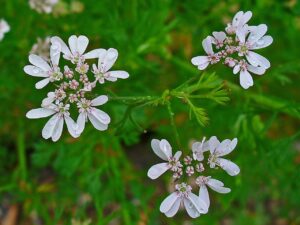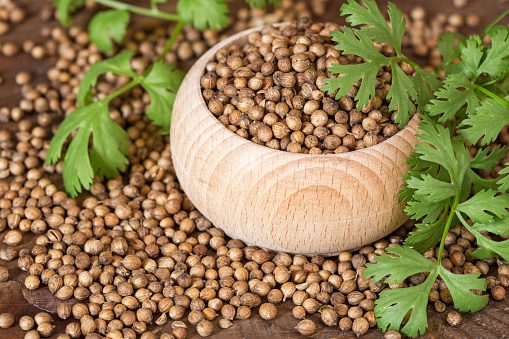Herb
Dhanyaka (Coriandrum sativum) Herb Ayurvedic Overview
Dhanyaka (Coriandrum sativum) consists of dried ripe fruits Linn. (Fam. Umbelliferae). It is a slender, glabrous, branched, annual herb having about 30-90 cm high. It is cultivated as a summer or winter yearly crop. At flowering, the plant can reach heights between 0.20-1.40 m. The plant has a taproot and germination in the epigeal. The stem of Dhanyaka is more or less erect and sympodial, monochasial-branched, sometimes with several side branches at the basal node. Dhanyaka or Dhaniya is widely distributed in Italy, Eastern Europe, China, Bangladesh, and India. It is majorly found in India, Karnataka, Madhya Pradesh, Punjab, Bihar, Maharashtra, etc.
Coriander effectively works for stomach and intestinal problems, including nausea, diarrhea, intestinal gas, upset stomach, constipation, etc. It is rich in diuretic properties that flush out the toxins from the body by increasing the volume and frequency of Urination.
Table of Contents
Scientific Classification of Dhanyaka (Coriandrum sativum):
- Kingdom: Planate – Plants
- Subkingdom: Tracheobionta – Vascular plants
- Superdivision: Spermatophyta – Seed plants
- Division: Magnoliophyta – Flowering plants
- Class: Magnoliopsida – Dicotyledons
- Subclass: Rosidae
- Order: Apiales
- Family: Apiaceae – Carrot Family
- Genus: Corindrum L. – coriander
- Species: Coriandrum sativum L. – coriander
Dhanyaka (Coriandrum sativum) Synonyms:
- Sanskrit: Dhanika, Dhanya, Vitunnaka, Kustumburu
- Assamese: Dhaniya
- Bengali: Dhane, Dhania
- English: Coriander fruit
- Gujrati: Dhana
- Hindi: Dhaniya
- Kannada: Havija, Kothambari bija
- Kashmiri: Dhaniwal, Dhanawal
- Malayalam: Malli, Kothampatayari
- Marathi: Dhane, Kothimbir
- Oriya: Dhania
- Punjabi: Dhania
- Tamil: Kottamatli virai, Dhaniya
- Telugu: Dhaniyalu
- Urdu: Kishneez
Dhanyaka (Coriandrum sativum) Description:
 a) Macroscopic: Coriandrum sativum fruit is rounded, mericarps usually united by their margins forming a cremocarp of about 2-4 mm in diameter. It is uniformly brownish-yellow, glabrous, sometimes crowned by the remains of sepals and styles. The primary ridges are 10, wavy and slightly inconspicuous, and secondary peaks are 8, straight, more prominent, endosperm coelospermous, odor, and aromatic, taste, spicy and characteristic.
a) Macroscopic: Coriandrum sativum fruit is rounded, mericarps usually united by their margins forming a cremocarp of about 2-4 mm in diameter. It is uniformly brownish-yellow, glabrous, sometimes crowned by the remains of sepals and styles. The primary ridges are 10, wavy and slightly inconspicuous, and secondary peaks are 8, straight, more prominent, endosperm coelospermous, odor, and aromatic, taste, spicy and characteristic.
b) Microscopic: The transverse section of fruit shows a pericarp with an outer epidermis and has a slightly thickened anticlinal wall. The mesocarp parenchymatous outer layer has inner cells in wavy longitudinal rows and has degenerated vittae as tangentially flattened cavities. The middle layer of mesocarp sclerenchymatous forms a thick layer of fusiform, sinuous rows with pitted cells. Its layer often crosses at right angles with definite longitudinal strands in the secondary ridges.
The inner cells of the mesocarp are large, hexagonal, and having lignified walls. The inner epidermis of very narrow thin-walled cells is slightly sinuous anticlinal walls showing parquetry. Each side of each mesocarp contains volatile oil, the endosperm of thick-walled cellulosic parenchyma having fixed oil, multiple aleurone grains, having about 4-8 in diameter containing micro-rosettes of calcium oxalate. The split carpophores pass at the apex of each mericarp into raphe, adjacent to the inner side, consisting of fibers surrounded by spiral vessels.
Identity, Purity, and Strength of Dhanyaka (Coriandrum sativum):
- Foreign matter Not more than 2 percent, Appendix 2.2.2.
- Total Ash Not more than 6 percent, Appendix 2.2.3.
- Acid-insoluble ash Not more than 1.5 percent, Appendix 2.2.4.
- Alcohol-soluble extractive Not less than 10 percent, Appendix 2.2.6.
- Water-soluble extractive Not less than 19 per cent, Appendix 2.2.7.
- Volatile oil Not less than 0.3 percent, Appendix 2.2.10
Chemical Constituents of Dhanyaka (Coriandrum sativum):
The major constituents of Dhanyaka (Coriandrum sativum) are .5–1% volatile oil, consisting mainly of delta-linalool (55–74%), alpha-pinene, and terpinene. It also contains flavonoids, coumarins, phthalides, and phenolic acids (including caffeic and chlorogenic). The aqueous extract of the roasted seeds is rich in acetylcholine and its precursor choline.
Dhaniya leaves are full of iron, magnesium, sodium, calcium, potassium, carbohydrates, fibers, folates, pantothenic, pyridoxine, riboflavin, vitamin E, vitamin K, thiamin, and many other healthy nutrients.
Ayurvedic Properties and Action of Dhanyaka (Coriandrum sativum):
- Rasa: Madhura, Katu, Tikta, Kashaya
- Guna: Laghu, Snigdha
- Virya: Ushna
- Vipaka: Madhura
- Karma: Chakshushaya, Deepan, Grahi, Hrudya, Pachan, Tridoshahara, Mutral, Rochan.
Ayurvedic Formulation made by Dhanyaka (Coriandrum sativum):
The most important formulations of Dhayaka or Dhaniya are Chandraprabha Vati, Brahmi Vati, Kalyanagulam.
Therapeutic Uses of Dhanyaka (Coriandrum sativum):
The main Indications of Dhanyaka (Coriandrum sativum) are Chardi, Jwara, Ajeeran, Trishna, Daha, Jwaraghan, Krumi.
Dose of Dhanyaka (Coriandrum sativum):
1-3 gm of the drug in powder.
Reference:
Ayurvedic Pharmacopeia of India.


